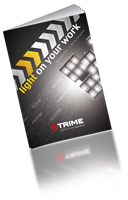How Alternative Lighting Towers Reduce Fuel Costs, Lower Emissions & Increase Efficiency
Contents
Introduction: Why Sustainable Lighting?
Portable lighting towers play an essential safety and access role on construction sites, film sets, festival sites, and events across the country. As diesel-powered assets, lighting towers are under increased scrutiny over their fuel use, running costs and emissions. This is especially the case within emission control zones, such as Greater London, where lighting towers are affected by the non-road mobile machinery (NRMM) regulations. Environmental regulations affect lighting tower users, whether the asset is owned or hired.
Even outside controlled areas, conventional lighting towers are frequently noisy and expensive to run. Fortunately, the latest generation of lighting solutions are more efficient and eco-friendlier – ultimately saving time, money, and stress.
This e-book is an introductory guide to sustainable lighting towers. Just as many other types of plant are now available in hybrid and fully electric versions, so it is with lighting towers.
Many larger companies that may need to hire plant equipment now have environmental policies in place that mandate choosing the eco-friendliest plant equipment available. This also applies when tendering for construction work. Demand for environmentally friendly plant equipment is at an all-time high, and at Trime we design and manufacture lighting solutions that use minimal power, resulting in dramatically less emissions.
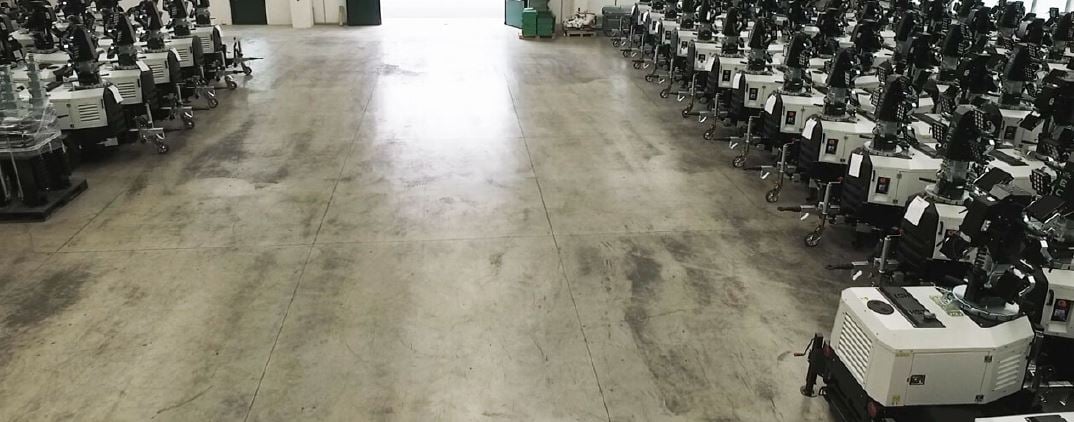
Businesses now have a choice of diesel-powered, hybrid, and electric (including standalone battery and solar) powered portable lighting. Alternatively-powered lighting towers are sometimes more expensive to hire, but usually cost less to run – yielding impressive overall savings. This guide explains the comparative benefits of each variation in terms of costs, running time, fuel efficiency, emissions, and other factors.
This guide is aimed primarily at businesses that use lighting towers directly – road contractors, construction businesses, event companies and so on – because it is at ground level that the real benefits of sustainable lighting are felt. The emphasis is therefore on operating costs and fuel use, as opposed to investment and maintenance considerations.
However, plant hire businesses may also find the guide useful as a way of explaining the benefits of alternative lighting options to their customers.
Contact details and some more information about our services are provided at the end of the guide. If you have any questions in the meantime, please don’t hesitate to call 01480 220 500 or email sales@trimeuk.com.
The Advantages Of Sustainable Lighting
In this section, we discuss the key features of sustainable lighting, and what distinguishes these solutions from more traditional forms of lighting.
There are two types of sustainable lighting tower: fully electric solutions and “hybrid” solutions. Both are characterised by reduced dependence on diesel as a power source, and the use of LED light heads. When combined, these are much cheaper to run than traditional lighting solutions.
As we’ll see, some sustainable lighting models also provide other advantages, such as lower noise output and better run time.
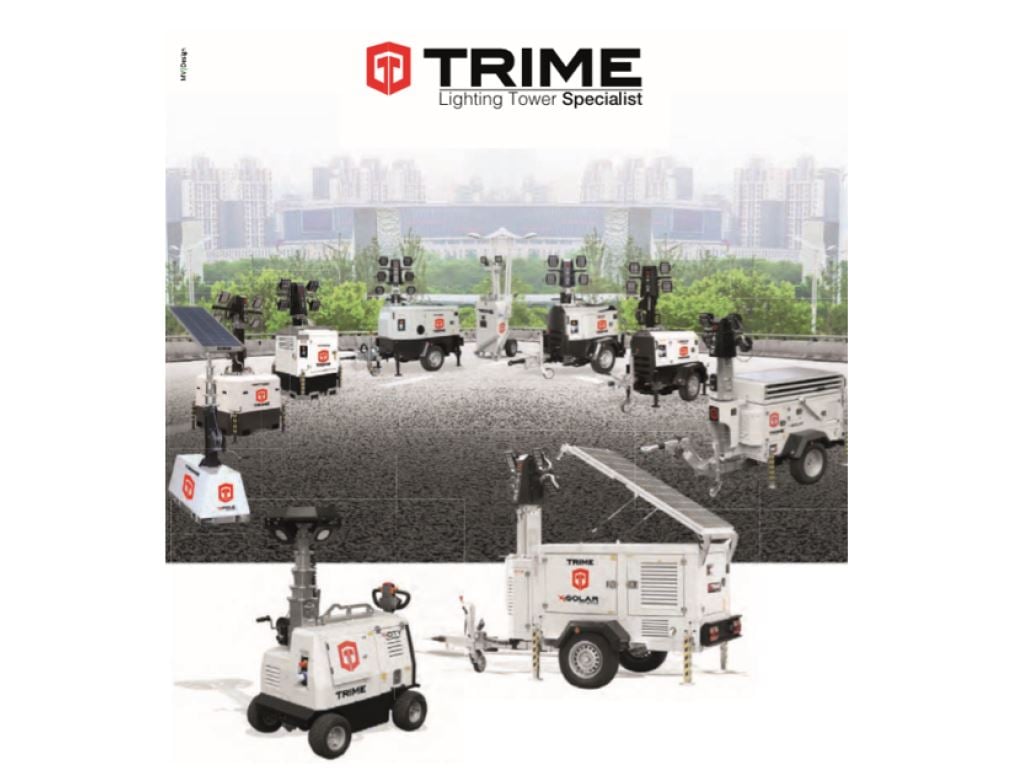
LED Floodlights
All sustainable lighting towers make use of LED floodlights. These are extremely efficient and offer several important benefits over halogen/halide floodlights.
Power: LED floodlight bulbs produce a powerful stream of white light, creating illumination similar to daylight. This makes them ideal for out of hours construction projects, and for lighting night-time event areas, such as sports playing fields. LED light bulbs can be varied to provide differing levels of light intensity and ambience - for instance, by using ‘warmer’ light temperatures. Lighting output is consistent in all weather conditions and temperatures. LEDs also have no warm-up time, allowing for instant, bright, white light.
Low heat emissions: LED floodlights are known for their low heat output. This has the cost advantage of all the energy you use going into lighting, rather than being dissipated as heat. It also makes LED floodlights safer than traditional alternatives, with a lower risk of fire and electrical failure.
Long service life: LED floodlights last up to 30,000 hours before needing replacement, far outlasting the average metal halide or halogen light bulb – which has around 2,000 hours runtime.
Lower risk of breakage: Metal halide and halogen flood light bulbs rely on a tungsten filament, which, when heated, causes the halogen gas within the bulb capsule to glow. These filaments are vulnerable to breakage when they overheat, or through impact, e.g. when the lighting array is moved or knocked. Individual LEDs have a lower risk of breakage because they do not rely on vulnerable filaments and are also protected by a strong plastic casing and metal heat shield.
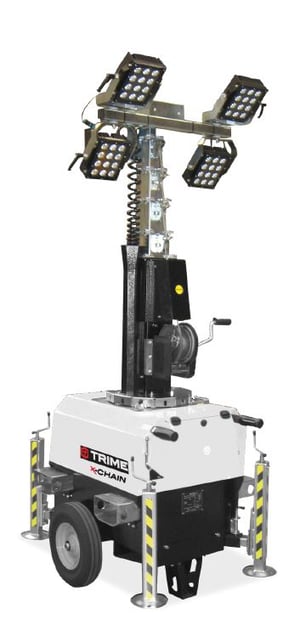
Energy efficient: LED floodlights use only a fraction of the energy required by metal halide or halogen bulbs. Businesses can save up to 80% to 90% of their temporary lighting energy costs by switching to a sustainable solution.
Non-toxic: LED light bulbs do not require the use of any toxic metals, such as lead and mercury, in their production. This makes it easier to recycle LED bulbs without risking a negative environmental impact.
Responsive: Some modern LED lighting sets have light sensors that automatically adjust the lighting output in response to ambient lighting levels, so that, for instance, lighting activates at dusk or when the weather darkens, and turns off when not required. This ensures you only pay for the appropriate amount of light. Other systems are equipped with motion sensors that only activate the lighting in the proximity of a person or vehicle.
Power Source
The advantages of LED lighting are so widely recognised that most new lighting towers – diesel ones included – now use them. What makes a lighting solution sustainable is not just the choice of floodlights, but also the power source.
Hybrid Lighting Towers
Hybrid lighting towers use a combination of battery/solar and diesel power, generally at a ratio of 80% - 90% electric to 10% - 20% fuel.
- In a battery-hybrid tower, diesel power is provided by a portable generator, which simultaneously recharges the battery while not in use. An efficient hybrid tower engine will only need refuelling every 300 operational hours and produces 86% fewer emissions, compared to a diesel-powered lighting tower. The battery can be recharged when under 22.2V. Charging can take place while the LEDs are still on, using power generated by the engine.
- Solar hybrid towers use solar panels as their primary power source, with a diesel generator as backup. How often the tower has to fall back on diesel power depends on the time of year and the level of light. Although solar panels are efficient at harvesting sunlight, more energy is available at the height of summer than in the depths of winter.
Solar-Powered Lighting Towers
Solar-powered lighting towers are fully electric and require no generator/diesel power to operate. They are the quietest and most sustainable lighting towers on the market. Charge comes from and is stored in the batteries, which is continually recharged through the solar panels. In some models the solar panels are mounted on separate ‘generator’ units, while in others the panels are integrated into the lighting tower. Each
panel is made from sensitive monocrystalline sheets that harvest the maximum amount of available sunlight. The charge is stored in lithium-ion batteries. To access power, the electric lighting tower is connected to the internal or external solar panel unit in the same way as a diesel engine. Solar energy units can be used to sustain a wide range of battery-powered machinery.
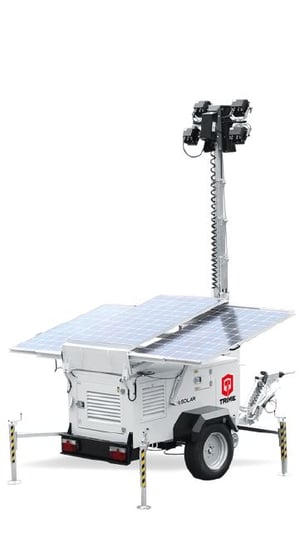
Plug-In Lighting Towers
Plug-in lighting towers are completely electric, operating from a mains source or a suitable generator. Towers such as the X-Chain are silent, release no emissions, and incur no fuel costs (except when being operated from a generator). Plug-in lighting towers last as long as they are connected to power and can light up to ten lights from a single source. Plug-in towers are small units – with up to 33 fitting into one truck for transport – which reduces transport costs and cO2 emissions when travelling.
Battery-Powered Lighting Towers
Battery-powered lighting towers take all their power from
high-capacity rechargeable batteries, with no dependence on solar panels or a diesel generator. These compact units are portable and produce no noise or emissions, making them a good option for enclosed environments, or work in residential areas. At Trime, our battery-powered towers operate on 12 V AGM batteries, which retain their capacity for 500 or more battery cycles. Recharging takes around 10 hours with the floodlights switched off, at which time the battery needs to be plugged into mains electricity or a suitable generator.
Running Time
Depending on the model, a hybrid or solar-hybrid lighting tower can boast an impressive run time of 1,000-3,000 hours per charge. This is a massive increase over the 60 hours average for a diesel-fuelled tower. Battery-powered towers have a run time of 36-72 hours. This is a massive increase over the 60 hours average for a traditional metal halide diesel lighting tower, and these lighting towers use no fuel too!
Transportation & Storage
Hybrid and electric lighting towers are easy to transport, move, and store. Moreover, as LED lights are smaller and more powerful than metal halide or halogen floodlights, the towers have a smaller footprint while providing the same or greater output. Like for like, you may not need to hire as many LED towers as you would halogen or metal halide towers to provide the equivalent coverage. The solar panel charging units needed for some solar electric towers do not take up any more space than a standard diesel generator.
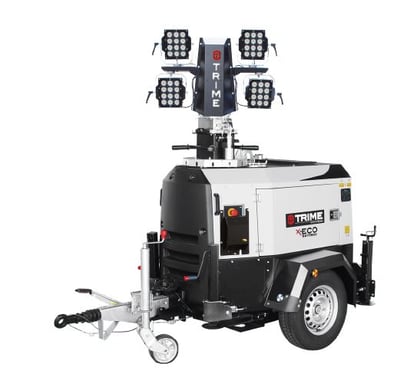
Compliance
Urban low emissions zones, such as those affecting Central and Greater London, have a big impact on the type of plant you can use.
Notably, the tightening of emission regulations in the UK suggests that all power generating equipment may soon be covered by statutory restrictions. Switching over to sustainable lighting solutions not only future-proofs your business against changes in regulations, but also demonstrates good practices by taking proactive steps to reduce carbon monoxide, nitrous oxide, and particulate matter emissions.
Frequently Asked Questions
What Are The Most Common Mistakes People Make With Sustainable Lighting?
Simply swapping out older, diesel-powered lighting towers for sustainable alternatives is not always the best strategy. Sustainable lighting is a diverse marketplace, and there are some common mistakes that come up time and again. Firstly, make sure you are fully informed about the capabilities of the lighting tower, especially when it comes to solar lighting. As we will explain below, there isn’t always enough solar energy available in the UK to power a purely solar lighting tower at all times of year. In winter, we recommend having a back-up power source for those dreary, overcast days – like a solar-hybrid lighting tower!
Secondly, not everyone considers how batteries are going to be recharged. After they are run down, batteries need to be connected to an external power source for 8-12 hours. This could be a mains electric point if available, but on a construction site you’ll probably need a generator or an
external solar panel unit. When using a hybrid unit, check your battery charge regularly. In the summer the battery won’t need recharging much at all, whereas in winter it’s worth checking the charge at least once a month.
Is There Enough Sunshine In The UK For Solar-Powered Lighting?
Usually, yes. In 2018 the UK was the sixthlargest user of solar power in the world, despite our dark winters and frequent cloudy skies. Solar power is an effective source of power for portable lighting towers, and during a summer heatwave like we’ve had the last couple of years, you’ll have no trouble running a fully solar outdoor lighting system.
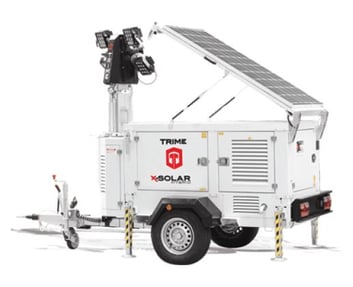 However, let’s not kid ourselves that British sunshin
However, let’s not kid ourselves that British sunshin
e is an infallible power source. Here, as elsewhere in Northern Europe, we are a long way from the equator, meaning that solar energy is far less efficient than – say – Mexico. There are also fewer hours of sunlight available in the winter than in the summer, while the efficiency of solar collectors is impinged by heavy cloud, rain, and snow.
For these reasons, solar-battery hybrids and battery-powered lighting towers are more common in the UK than full solar electric towers. Solar panels provide the primary power source, with a battery or generator on hand for supplementary power, for when there is not enough light.
How Easy Are Hybrid and Electric Lighting Towers To Maintain?
Hybrid and solar lighting towers are reliable, robust, and don’t need extensive maintenance. We recommend cleaning your solar panels after every use, as leaves, dust, and debris may reduce their efficiency. Engines for hybrid and diesel units should be serviced every 500 hours of use, during which they will need an oil and oil filter change. Battery packs require no attention unless you suspect a problem. A full service and inspection is recommended every 12 months.
Our Greenline Sustainable Lighting Solutions
Sustainable lighting is changing all the time, and within the broad categories of hybrid and electric lighting, there are many different options. At Trime, we offer our Greenline range of eco-models for hire, alongside our fuel-efficient diesel lighting towers. These recognise that different applications have different needs, and our range covers this.
How Our Greenline Models Compare With Standard Lighting Towers
The table below shows a side-by-side comparison of our standard metal halide, dieselpowered lighting tower, with the four models in the Greenline range:
X-Eco: Our most efficient diesel-powered lighting tower. The X-Eco uses only 0.55 L of fuel per hour, giving 200 hours of run time on a full tank. The tower can illuminate over 3000sqm of land and 14 can be transported per truck.
X-Battery: The Greenline X-Battery is a compact, battery-operated lighting tower, with a long run time and silent, emission-free operation. The X-Battery is the first purpose-designed lighting towers to run on 100% battery power. These towers produce no emissions and have no fuel costs. The X-Eco Battery series is the mobile range available from Trime.
X-Hybrid (Battery): The X-Hybrid uses a powerful
combination of battery power and a fuel-efficient back-up diesel engine. It is capable of 18 hours noisefree operation on a single charge and provides a 90% reduction in fuel costs compared to a standard diesel lighting tower. A wheeled X-Hybrid City and compact X-Hybrid Mobile are available for residential projects.
X-Solar Hybrid: The X- Solar Hybrid features a telescopic lighting mast and integrated solar panels. The four 100 W LED floodlights draw on solar energy when available, supported by an electronic, batterypowered engine. Fuel use when the engine is running is as little as 0.1 L per hour of light, with refuelling required after approximately 3000 hours.
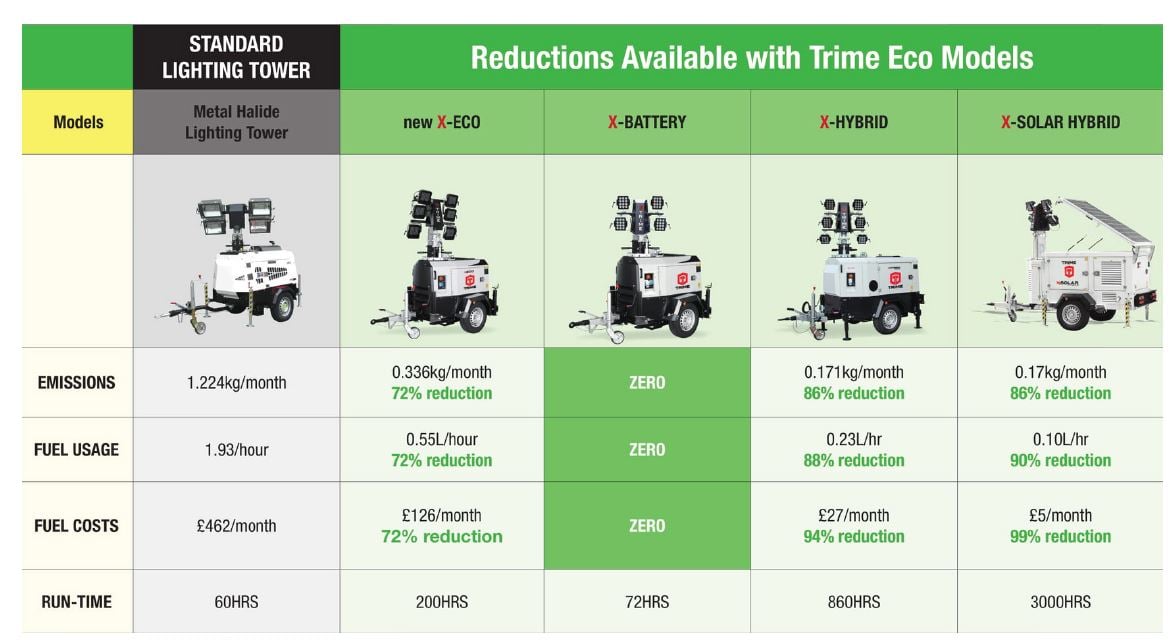
Trime: Lighting Tower Specialists
Trime UK Limited are a specialist lighting tower manufacturer, designing and producing advanced, eco-friendly lighting solutions for the plant hire market.
This allows us to offer innovative, sustainable lighting solutions based on the lighting needs for all applications and sectors. With over 60 years’ experience in the industry, we provide tailored support and a high level of customer service throughout the hire process. Our consultative approach to lighting tower hire gives our customers excellent value for money and access to market-leading products, selected for their project.
All our lighting towers are manufactured in Italy, in a modern, 20,000 m² design and production facility. All stages of the process take place on-site – from concept design to metalwork, electrical assembly, powder coating, and testing. Our designs incorporate the highest quality lightweight materials, with energy-saving technologies and advanced safety features – to produce the most reliable lighting towers available on the market.
Find Out More
Thank you for downloading this guide. To discuss our Greenline range, parts ordering, or inspection/maintenance services with one of our team, please get in touch by phone or email.





